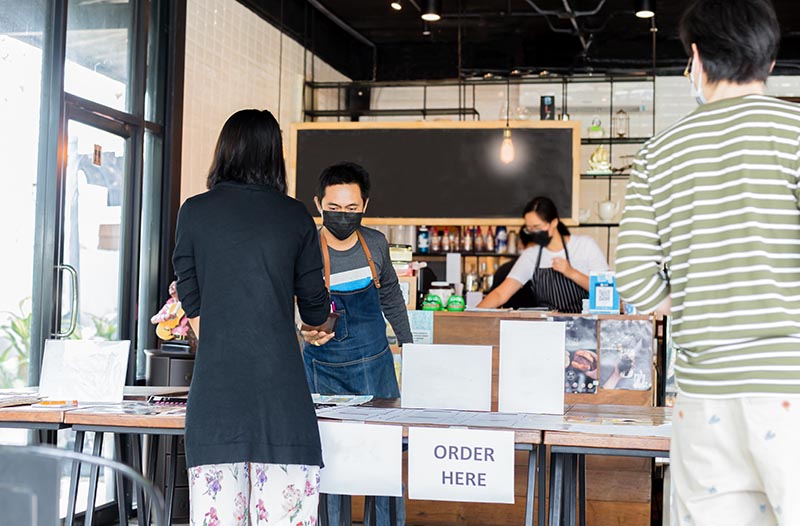Bars and restaurants—once the center of social activity for millions of Americans—have been greatly impacted by the COVID-19 pandemic. The National Restaurant Association estimates that the restaurant industry has lost more than 3 million jobs and $25 billion in sales since March 1, and the numbers keep growing.
Many in the industry have tried to adapt by converting operations to take-out only, but clearly, this is a stop-gap measure. Other bars and restaurants are taking it a step further, hoping that their innovative approaches lead to higher sales than the takeout-only approach and foster customer loyalty that extends post-pandemic. Let’s examine.
Flour and toilet paper, with a side of dinner and beer
There’s been a lot written about consumer shortages of staples such as flour and toilet paper. It’s a supply chain problem: in a normal market, X% of these products go to the consumer market and Y% go to the business market. With people now staying at home, there’s a much greater demand in the consumer market and a lower demand in the business market. But because the supply chain can’t keep up, there’s a consumer shortage and a business glut. That’s why we’ve seen pictures of farmers dumping milk – that milk was meant for schools and restaurants, but there’s now no demand there and the system is ill-equipped to redirect product.
So what is a business to do when it finds itself with a whole lot of flour and yeast that it used to make pizza, but not many patrons who want that pizza? Or what about all those paper towels or toilet paper in stock for non-existent customers? Some businesses are now turning around and offering their glut of products to consumers.
That’s the situation I recently found myself in when my local grocery store had no flour in stock. Like many people during the pandemic, I’ve found my moments of solace in cooking and baking. I was running low on flour that I use for my homemade bread and pasta, and heard that Jack’s Abby, our local craft brewery and restaurant, was selling 5-pound bags to consumers.
Sure enough, the brewery was selling not just flour, but also yeast, paper towels, toilet paper, and boxes of veggies – many of the very products facing shortages at the grocery store. Did I buy my flour there? Yes, four bags of it. Did I also get takeout dinner and beer? You bet.

Buying in bulk
Other restaurants also realize that they have far too many ingredients and not enough buyers for the products of those ingredients. This is especially problematic for those restaurants that find themselves with a surplus of perishable ingredients, such as vegetables.
Crisp & Green, a chain in the Minneapolis area, has been offering customers the option to buy ingredients in bulk. For $195, customers can buy 20 servings worth of fresh ingredients that they can later assemble at home.
Food distributor Sysco is now offering advice to its restaurant customers on how they too can sell ingredients to customers in “pop-up shops.”
Cocktails to go
Bars are closed, and according to the federal government’s three-phased plan to reopen the economy, they won’t be allowed to open until Phase Two, which is after restaurants are allowed to reopen.
Some innovative bars are now offering cocktails to go. With many states relaxing restrictions on alcohol during the pandemic, it’s now realistic for these businesses to continue to sell their drinks even though patrons can’t come inside. In Alexandria, Virginia, the local visitor center has published a list of bars offering cocktails to go.
One of these bars, Captain Gregory’s, is offering a “speakeasy to go” in conjunction with its sister restaurant, Elizabeth’s Counter. When patrons buy at least two meals, they can bring home one of four batches of specialty cocktails that serves four people.
Virtual events
Other bars and restaurants are bringing their regular in-store events to the virtual realm. For example, many bars have been hosting virtual trivia nights on platforms such as Facebook Live. One bar that recently did so is The Casual Pint in Lexington, South Carolina, which urged its customers to come and buy beer at the store to drink during trivia night at home.
Wineries are also having virtual tasting events. For example, Aperture Cellars was set to open doors in Napa Valley in April, but that wasn’t possible due to the pandemic. Instead, the winery is hosting virtual events on Thursdays on Instagram Live until it can open in person.
Giving back to the community
Finally, many bars and restaurants have recognized during this time that while times may be tough for them, they have the unique opportunity to improve someone else’s difficult time.
Jack’s Abby, where I bought my flour, also allows people to buy donation pizzas, which it then distributes to workers at our local hospital or to a local food shelter.
Mickey’s N.Y. Pizza in Hudson, New Hampshire, has been offering free slices to customers who can’t pay for their meals, while Luk’s Bar and Grill, also based in Hudson has been giving out free bagged lunches for kids. My colleague, Ally Nicoli, tells me she has bought food from both of these places in appreciation for their generosity.
Conclusion
It is certainly a challenging time for bars and restaurants, and undoubtedly, many of them will not be able to return to business after the pandemic is over. However, many are doing their best to not just survive during these times, but also to test out new and innovative models that could ignite their businesses once restrictions are lifted.
Related reading
- How Businesses Can Manage Their Supply Chains During the COVID-19 Pandemic
- How to Take Advantage of the Shift from On-Premise to Off-Premise Drinking
- 5 Feel Good Ways to Help Your Community and Self During a Health Crisis
- Navigating the Future: Trends in Wine Tasting Rooms - July 16, 2024
- Why You’ll Want to Attend DIUC24 - June 20, 2024
- The Role of Technology in Solving Nursing Challenges - May 6, 2024



